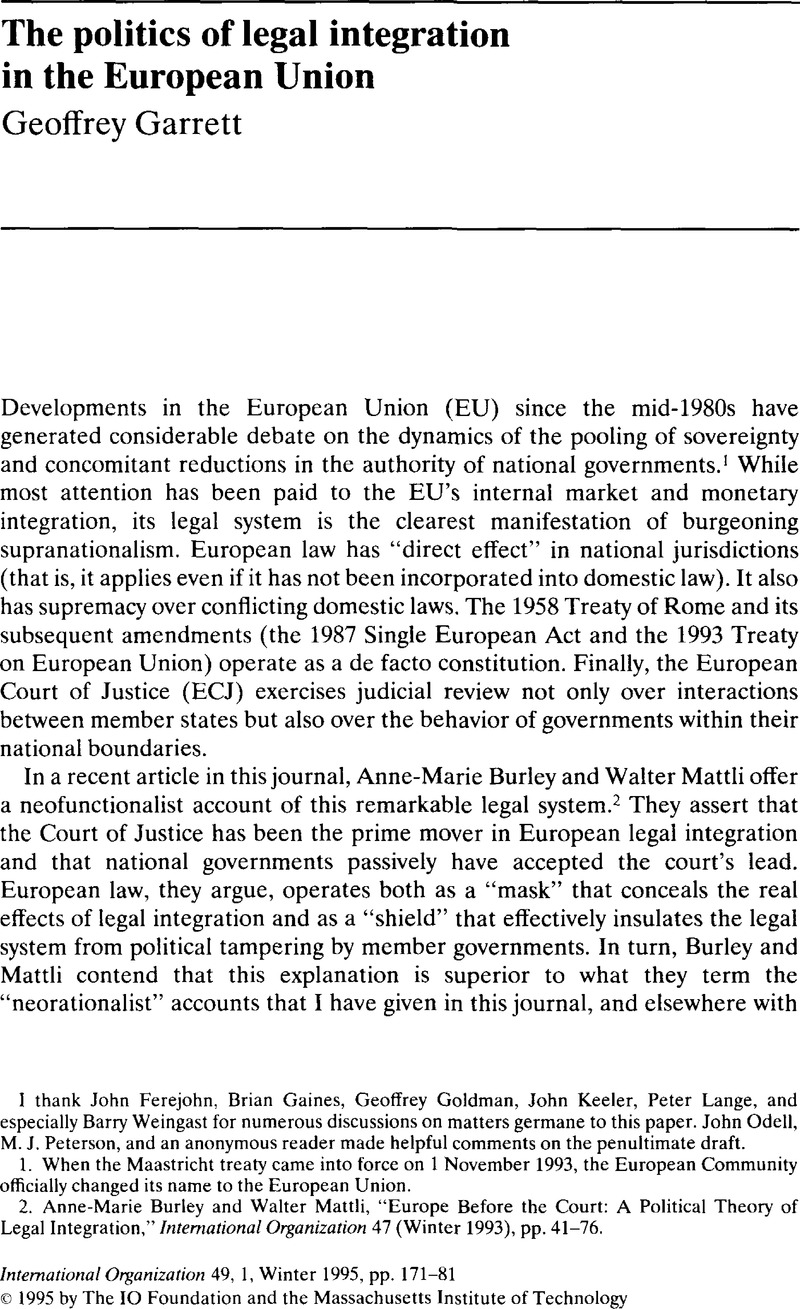Published online by Cambridge University Press: 22 May 2009

I thank John Ferejohn, Brian Gaines, Geoffrey Goldman, John Keeler, Peter Lange, and especially Barry Weingast for numerous discussions on matters germane to this paper. John Odell, M. J. Peterson, and an anonymous reader made helpful comments on the penultimate draft.
1. When the Maastricht treaty came into force on 1 November 1993, the European Community officially changed its name to the European Union.
2. Burley, Anne-Marie and Mattli, Walter, “Europe Before the Court: A Political Theory of Legal Integration,” International Organization 47 (Winter 1993), pp. 41–76.CrossRefGoogle Scholar
3. See Garrett, Geoffrey, “International Cooperation and Institutional Choice: The European Community's Internal Market,” International Organization 46 (Spring 1992), pp. 533–60CrossRefGoogle Scholar; and Garrett, Geoffrey and Weingast, Barry, “Ideas, Interests, and Institutions: Constructing the European Community's Internal Market,” in Goldstein, Judith and Keohane, Robert O., eds., Ideas and Foreign Policy (Ithaca, N.Y.: Cornell University Press, 1993), pp. 173–206.Google Scholar
4. Burley and Mattli, “Europe Before the Court,” p. 51.
5. On the first point see Magee, Stephen et al. , eds., Black Hole Tariffs and Endogenous Policy Theory (New York: Cambridge University Press, 1989).Google Scholar
6. Neoclassical economic theory (and official EU publications) suggests that all countries will gain in aggregate from the completion of the internal market, but even if this is true in the longer run, it is clear the benefits of trade integration in the shorter term are not distributed evenly among members. See Smith, Dale L. and Wanke, Jürgen, “Completing the Single European Market: An Analysis of the Impact on the Member States,” American Journal of Political Science 37 (05 1993), pp. 529–54.CrossRefGoogle Scholar
7. Burley and Mattli, “Europe Before the Court,” p. 51. For the text of the Cassis de Dijon case, see Case 120/78, Rewe–Zentral AG v. Bundesmonopolverwaltung für Branntwien (Preliminary ruling requested by the Hessisches Finanzgericht), ECR 649 (European Court of Justice 1979).
8. Articles 169 and 170 allow for cases to be brought in the Court of Justice against national governments for violating their treaty obligations. Article 171 explicitly states that members must comply with ECJ decisions. Article 177 encourages national courts to request from the ECJ preliminary rulings on the application of European law to domestic cases. See Treaties Establishing the European Communities (Luxembourg: Office for Official Publications of the European Communities, 1987).Google Scholar
9. For an analysis of this relationship, see Geoffrey Goldman, “National Courts, Governments, and the European Court of Justice: A Bargaining Model of EC Legal Integration,” mimeograph, Stanford University, Stanford, Calif., 1993.
10. Burley and Mattli, “Europe before the Court,” pp. 73–74.
11. See Roger G. Noll, “The Economics of Politics and Deregulation,” Jean Monnet Chair Papers, The European Policy Unit at the European University Institute, Badia Fiesolana, Italy, 1992; and James A. Caporaso and John T. S. Keeler, “The European Community and Regional Integration Theory,” paper presented at the third biennial international conference of the European Community Studies Association, Washington, D.C., 27–29 May 1993.
12. Garrett, “International Cooperation and Institutional Choice,” pp. 555–56.
13. For a recent critique of the conventional wisdom about the importance of the Cassis decision itself in the completion of the internal market, see Alter, Karen and Meunier-Aitsahalia, Sophie, “Judicial Politics in the European Community: European Integration and the Pathbreaking Cassis de Dijon Decision,” Comparative Political Studies 26 (01 1994), pp. 535–61.CrossRefGoogle Scholar
14. Smith and Wanke, “Completing the Single European Market,” pp. 537–46.
15. See Woolcock, Stephen et al. , Britain, Germany, and 1992 (London: Pinter, 1991)Google Scholar; and David Soskice and Sigurt Vitols, “Financial Deregulation in the New European Community,” manu-script, Wissenschaftszentrum, Berlin, 1993.
16. Burley and Mattli, “Europe Before the Court,” p. 71.
17. The Justices of the ECJ hold renewable six-year terms. Each member government selects one justice; they jointly choose one additional justice.
18. Cinetheque, 1 CMLR/365 (1986).
19. The importance the French government attaches to the film industry was demonstrated graphically in the end game to the Uruguay Round.